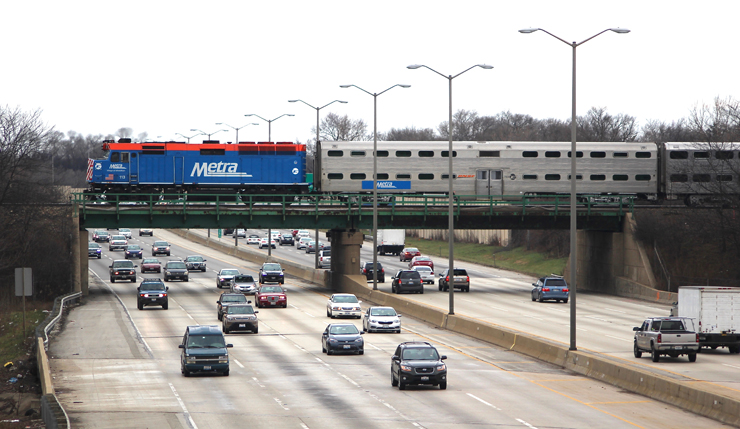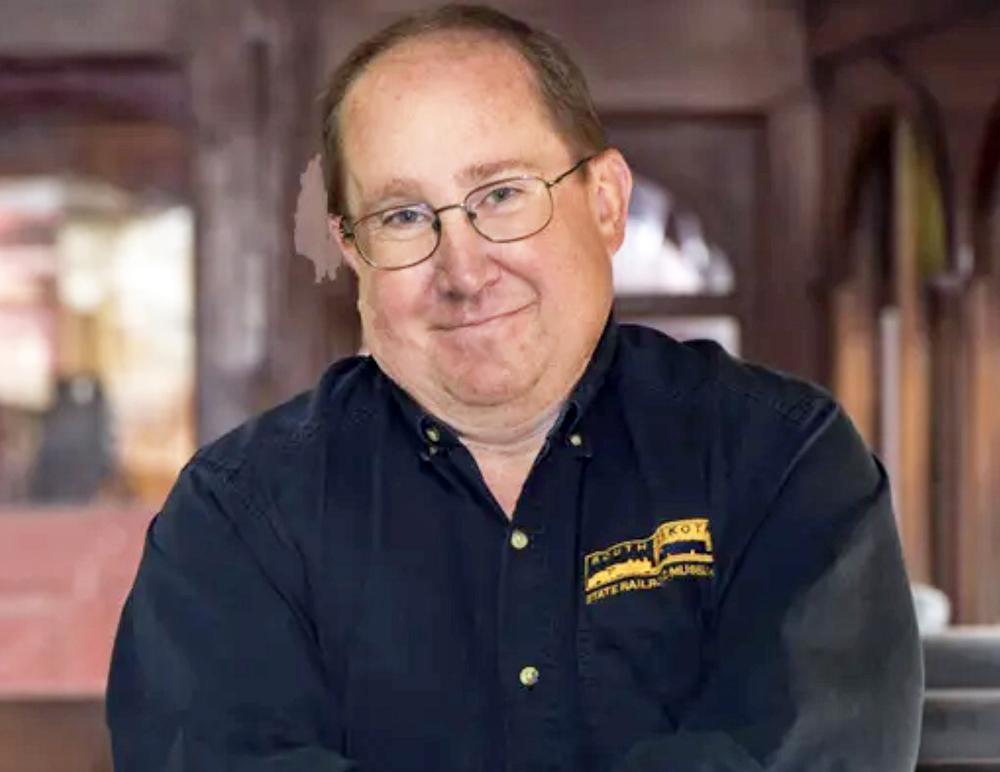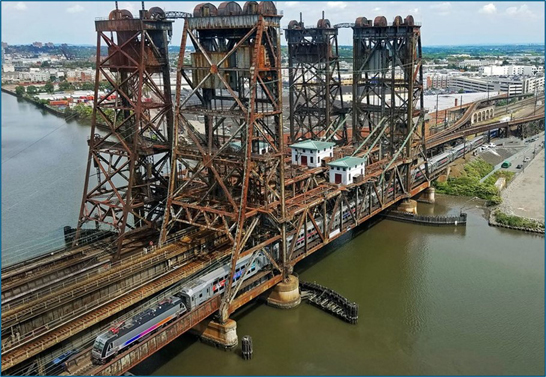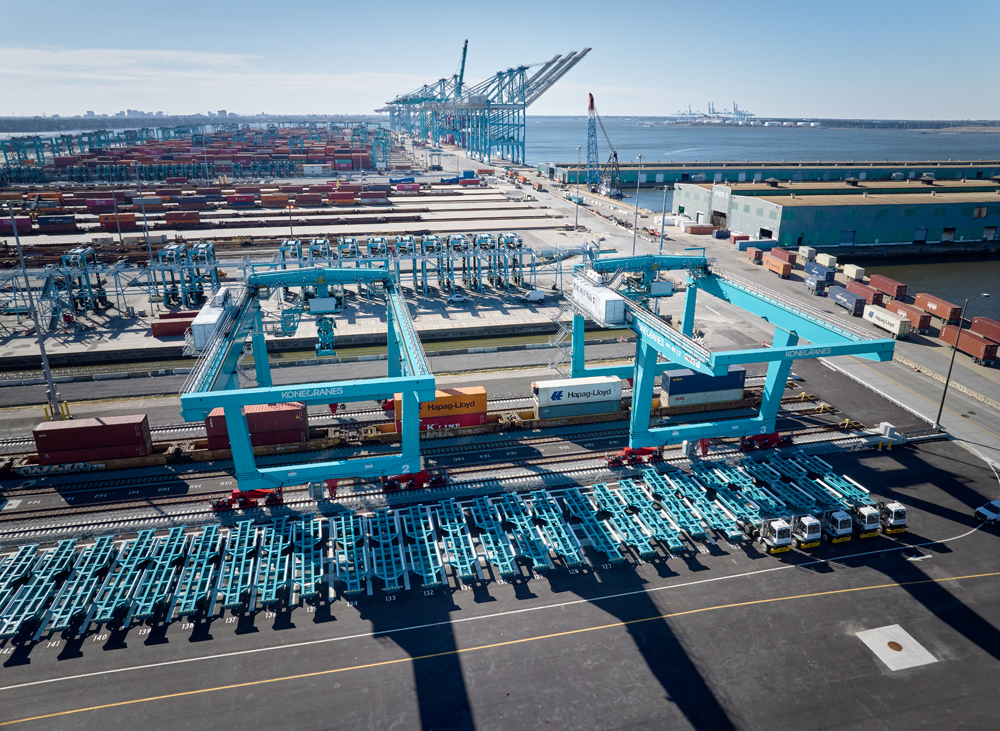HINSDALE, Ill. — Planning is underway for the widening of an Illinois toll road that will require BNSF to build a new bridge on its triple-track main line west of Chicago, although Hinsdale opposes the project, the Hinsdale Doings reports.
The BNSF bridge over Interstate 294 between Hinsdale and Western Springs is the narrowest point on the stretch of highway that is to be widened from four to six lanes in each direction. To replace it, the railroad will build a shoofly with a three-track temporary bridge, then remove and replace the existing bridge. More than 150 Metra, BNSF, and Amtrak trains use the route daily.
The project’s timeline is a lengthy one: Site preparation is projected to begin in August 2019 and take a year, with the construction of the temporary bridge from August to December 2020. The removal and replacement of the current bridge would follow in 2021.
Neighborhood concerns over the project include the possibility that construction will encroach onto residents’ property, construction traffic, and the construction of a railroad siding that will be used to store maintenance equipment.
The complete story is available here.















This widening of I-294 will consume all of the ROW the authority purchased in the 1950’s through this part of the suburbs and cannot be expanded further without demolishing large tracts of homes. It’s just not likely.
The 3 track bridge BNSF uses was built by the tollroad in the 1950’s for the then Burlington. While the bridge today does contain a ledge for a 4th rail, it would be of little value as the ROW is pinched in both downtown Hinsdale and Western Springs and would require large platform relocations in their downtowns to make the extra rail usable.
A bridge design that could remove the center pillar in the tollroad and still support the weight of 3 rails of traffic would be ideal. Increase the bridge setbacks 20 yards in each direction to the tollroad ROW boundary will insure that there will no longer be any requirements to modify the bridge during its useful life.
Nathan,
Highway projects have what they call “Force Account” work. Typically, this includes any railroad relocation work. And, yes the railroad pays for this work to get done, and then is reimbursed by the highway project. Mr. Norton is correct, the highway project also pays for a railroad flagger to be on-site to coordinate rail traffic and construction traffic. For example, the flagger will get a track-time permit while the construction crew is lowering a bridge beam into place to make sure there is no train in harm’s way, if something disasterous were to happen. Working around the railroad will slow down progress on the construction project, and raise the cost.
BNSF should make sure that the new rail overpass will take in consideration future Lane additions of I-294. In 20/25 years 2 or more lanes might be added. Also BNSF “should” put in foundations for a wider bridge. They wouldn’t have to to put in the bridge at this time. If the foundation was already in place, hanging steel for a wider bridge (for a fourth track) wouldn’t take much effort or time.
A sure way to increase congestion is to increase capacity. https://www.citylab.com/transportation/2018/09/citylab-university-induced-demand/569455/
As if adding a lane at great cost exemplifies progress in easing “congestion” whereas the opposite occurs.
It’s quite possible that the public is paying a significant portion of the cost, as it should be.
Why is BNSF paying for it and not the highway project? Presumably the RR was there long before interstate was even a word.
Will the average wage earner be able to afford to own a vehicle in next 20 or 25 years with obligated safety expensive electronic devises added on and repair costs to rise with all of these additional features? Once I-294 is widened an extra four lanes then long-term planning must allow for that space for future LRT or BART use along the median space.
Good to see the residents are more worried about a temporary railroad realignment than about the increased pollution from the highways lanes. Ya gotta keep your priorities straight! (BNSF might as well double the length of the bridge while they’re at it, as it will be 16 lanes in both directions in 50 years anyway).
I can’t help thinking about the amount of land that is swallowed up by an Interstate Highway that is eight lanes wide, plus entry and exit ramps, etc., versus the number of passengers those three tracks are capable of carrying in an equal amount of time.
Thank you for this story! Please note that the link at the end of the story is inoperative.
You guys all do realize that I-294 was rebuilt in the 1990’s. Twenty-five years later, let’s rebuild it! Fact is, even in Chicago and New York and even Boston, a whole lot of people drive. …. Who pays for this? 100% by the toll authority. The railroad would likely do some of the work, like tracks and signals, which would be 100% reimbursed. The toll authority would also have to reimburse BNSF for 100% of the costs of railroad supervisors watching out for their trains in the construction zone, at an hourly rate set by the railroad.
The story states “will require BNSF to build a new bridge…” which seems to imply they’re paying for it. If they’re building it and another entity is paying, then the story should be made more clear in that regard. It’s called reporting.
In these situations, the railroad with its right of way was in place long before the highway, so the railroad has the upper hand. Therefore, the entire cost of the new bridge including its design and permitting along with the cost of the temporary ‘shoo-fly’ trackage will be incurred with the Toll Authority or DOT. The new bridge will also need to be built to more stringent building codes with likely greater lateral clearances between the three tracks than the existing bridge and typically with extra room for an additional track.
Il. Rt.83 north and south of Hinsdale is a 6 lane road but squeezes down to 4 lanes through Hinsdale and Clarendon Hills causing a bottleneck for drivers. When the road expansion was proposed the money’d people of those two towns fought tooth and nail against it, And they won and everyone that uses the road lost.
I meant to comment that I didn’t see anything in the article about BNSF paying for any of this–which they shouldn’t, unless they incur any betterments as a result.
A lot of the funding should be covered by the tolls that users pay. I haven’t heard of any increases proposed lately, but wouldn’t be surprised to hear of them once work begins (and they never seem to go back down).
Widening the stretch of road they’re talking about will destroy two of the Oases that currently go over the highway (there will still be convenience stops alongside the roads at these points, I presume). There will also need to be bridges expanded over railroads at several points, including at least one lane in each direction on the “mile-long” bridge over the old AT&SF (with the UPS yard), GM&O, canal, and Des Plaines River, and the bridge that curves over a highway and the east end of CP’s Bensenville Yard (that one will definitely have two lanes added in each direction).
In addition to all of this, the Tollway that bypasses Chicago (I-294) will have a bypass of its own, I-490, around the western edge of O’Hare, which will in turn connect with Illinois 390 and probably a new western access point to O’Hare. This is the highway that CP was complaining about encroaching on its property.
If you plan on traveling in the area at all, and don’t have an I-pass (or EZ-Pass) transponder, now’s the time to get one…people with the transponders pay half the rate of those without–and, as I mentioned at the top, I wouldn’t be surprised to see tolls escalate for all of this!
Yea ok, Good luck. The railroad hasn’t “have” to do anything.